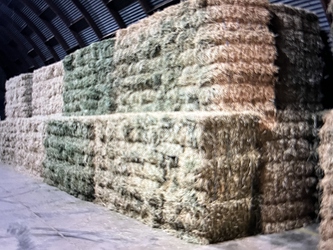I’ve seen horse keeping on both coasts for maaaaany years but only now have I encountered stacking square bales cut side up, or on their side such that the strings are parallel to the floor and not touching the “floor.” The cut hay sits vertically. Kind of like a brush jump  I have only ever seen square bales stacked flat such that the strings are on the floor: the cut hay sits horizontally parallel to the floor. Cut side up is totally new and foreign to me. Maybe this practice evolved with small square bundles.
I have only ever seen square bales stacked flat such that the strings are on the floor: the cut hay sits horizontally parallel to the floor. Cut side up is totally new and foreign to me. Maybe this practice evolved with small square bundles. 
The theory is better air circulation within the bale. Would the same theory not also apply to moisture wicking up into the bale?
So I want to know what is more common. Stacked with the flat side down or stacked with the cut sides up and down?
- Bales stacked cut side up
- Bales stacked flat
0 voters


 , but let’s leave the
, but let’s leave the



